By : Ayad Attar
The verb “Khazak” in Arabic means penetrating or stabbing, It is the source of the word “Khauzakah” – Impalement, which refers to an inhuman sadistic practice based on the use of a wooden stick with a pointed tip that is pushed through a human body, often through the anus or vagina, then they lift the stick up in the air and hold it to the ground vertically, and the victim rises with it as if he is sitting over it, and the tip of the stick begins to dive into his body more and more by gravity, until it penetrates the viscera and comes out again across the shoulder or mouth. The speed of death varies according to the experience of the executioner. The more the tip of the stick is pointed, the more greased it is, the faster it passes through the body, and the sooner death occurs.
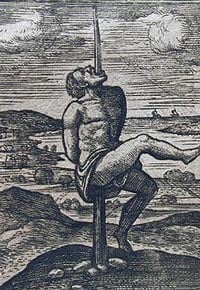
The medieval executioners had creative ways and methods to increase agony. Perhaps they used a thick stick and made its head flat, so as to not penetrate the body quickly, and keep the victim alive on the stick for several hours, or even days. To increase the agony even more, they sometimes feed the victim and then make him drink a laxative drink to double the pain as he/she cannot defecate because of the head of the stick that blocks the anus.
A professional executioner was able to push the stick without rupturing the internal viscera, leaving the victim alive for as long as possible, and you can imagine the magnitude of the suffering and pain of the victims, especially those who have lived for a longer time. They would moving their bodies from side to side to get some comfort, just like what a modern traveler does when he/she spends long hours on the bus chair, but the problem with the impalement is that each movement leads to further penetration of the stick’s pointed head more and more inside the body.
Crucifixion and Impalement
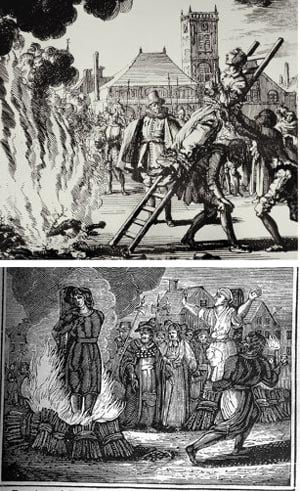
Through my quick research for sources to write this article, I noticed that people sometimes confuse between crucifixion and impalement, even though the difference between the two punishments is obvious, crucifixion is the bounding of a victim to a long wooden stick or trunk of a tree or a rock or a castle wall etc… by ropes and nails. The crucified victim may remain alive for several days and dies only after being starved or dehydrated, or may be killed on the wood by flogging or stoning or burning. All the nations knew the crucifixion and practiced it, until the cross became a living part of human memory and culture, when the stick that was used in the crucifixion of Christ turned into the most famous religious icon in the world.
So crucifixion is basically bounding the human body to a stick, while the impalement is to fix the stick to the human body. There is no doubt that the latter was more severe on the victim than the first, it is true that the two penalties are close in sadism and brutality, and that the consequence of both is one, as one Arab poet said:
Whoever does not die by the sword
Will die with something else
There are many reasons for death
But the result is one
But I think that the impalement was aimed beyond the execution of the person, otherwise why the executioners took all this effort to impale a person while they can kill him easily with one sword strike, and why they sometimes bring his wife and female relatives to watch… I assume that the original purpose was to humiliate the victims and break their will. It is clear that this punishment includes humiliating sexual connotations, especially for men.
Impalement also play a large role in spreading terror and panic in the hearts of people, the armies of the Middle Ages, for example, might impale some prisoners of war near the walls of besieged cities, in order to break the morale of the population and intimidating them with the possibility of meeting the same miserable fate if they keep resisting, which leads them to surrender their city without a fight.
Also the rulers may turn to impalement to intimidate their political opponents, discourage rebels, or intimidate thieves and criminals.
The first impalement
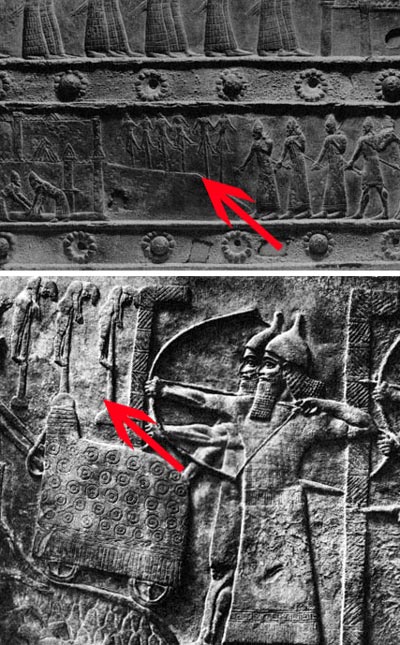
The search for the first impalement in history is more like searching for a needle in a haystack, because it’s an ancient sadistic practice, perhaps the first impalement was only a minor distortion of the crucifixion process itself.
It seems that the Assyrians were among the first and most fond of the impalement, they portrayed this terrible punishment in their stone monuments about their victories against their enemies. The Assyrians were a Semitic people who settled in modern-day northern Iraq and were known for being too harsh in their dealings with their enemies, from flaying prisoners while they were alive, to putting people in skewers and then set them on fire… they didn’t hesitate to kill elderly, women and little children, as well as displacement and enslavement of entire cities’ inhabitants. Their terrifying reputation preceded them wherever they went; they established a fear-based empire that extended to and included parts of modern-day Iraq, Iran, Turkey, Syria and Egypt.
But the predilection of the Assyrians to the impalement does not mean that they were the first to use it, and their brutality in dealing with their enemies is not as unique in the old world as some might think. Long before the Assyrians, the impalement was present in the obelisk of the Babylonian king Hammurabi (1750 BC), where one of the laws states:
“If a woman causes death to her husband for the sake of another man, she must be impaled”
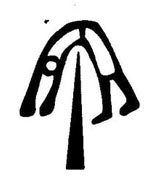
In ancient Egypt there are signs of the use of impalement since the thirteenth Dynasty (1675 BC). One of the punishments was to execute a person by placing him on a pointed stick. There is a clear hieroglyphic sign that refers to this punishment, in the form of a stick embedded in a human belly.
There are also many historical texts that point to the use of impalement by the Chaldeans, Persians and Romans, but here we stand again before the dilemma of distinction between crucifixion and impalement when dealing with these texts, most likely that most of these old references, including what is mentioned in the Old Testament, Which talked about the suspension of people on trees and on wooden pegs, were in fact referring to crucifixion, of course not necessarily the crucifixion over two pieces of wood as in the cross of Christ, but also crucifixion on a single stick or pole, because of the ease of preparation and speed of completion, and perhaps from here came the great confusion between crucifixion and impalement.
Middle Ages
During my quick research on the Arab historical sources related to the pre-Mongol invasion, and I don’t claim, of course, that I searched all the sources, but I looked at the most famous, such as (The Complete History) by Ibn Al-Athir (1231 AD) , (History of the Prophets and Kings) by Al-Tabari (915 AD) … and I found no mention of the impalement, the common punishments at that time were lashing, decapitation, cutting off the limbs and then crucifixion, and rarely crucifixion of the people alive, except in special cases we will return to it in a separate article in which the crucifixion is detailed.
There is only one incident found in (The Meadows of Gold) by Al-Masudi (950 AD), which is in fact does not talk about impalement and do not mention it by name, but as a punishment, it is very close to the impalement, where he says:
“The man (one of the advocates of the Alawites) and the Al-Mu’tadid (Caliph Abbasid) had a long controversy, and in his address to Al-Mu’tadid the man said: even if you grilling me on fire, you will not get from me more than you’ve heard, and I will never report and hand over the man who I called people to obey him, and I recognized him as my Imam, so do what you want to do. Al-Mu’tadid replied: We will not torture you except by what you mentioned. And they brought a long iron rod and inserted it in the man anus until it pulled out of his mouth , then put him on fire until he died while he cursing the Al-Mu’tadid and saying ugliest insults on him”.
This rare incident is no evidence of the use of impalement in the Abbasid period, or rather, no evidence of its widespread use. We don’t know for sure when and where the impalement was first practiced in the Arab and Muslim world. I think it’s one of the imported punishments, like Tawseet (Cutting the person into two halves from the middle) and flaying, which the Mongols brought with them or came with the Tatar and other nomadic Turkish tribes.
Whoever brought the impalement with him, it certainly was not an Ottoman invention as people imagine, nor were the Ottomans the first to use it, It is most likely that it did not appear until the Mamluk era (1250–1517 AD). The oldest references to it date back to the beginning of that era. Among them is what was mentioned by Badr al-Din al-‘Ini in his book “Pearl necklace in the history of the people of time”, where he reported a story about impalement carried out by a Mamluk prince after a battle, and the victims were prisoners of war from Ilkhanate (1256-1353 AD). He said:
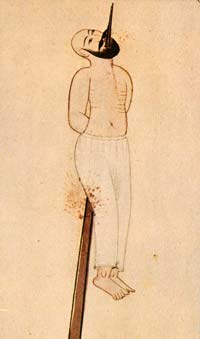
“They took the Ilkhanate prince and brought him to Qatlushah (another Ilkhanate prince) who was impaled and dead on the stick and his corpse was rotten, when he saw him on this situation he cried and shouted, and then he saw that they had set another stick next to the corpse. He said to them: What is this? They said: This is your seat, which we ordered to sit you on it. He said: “O men don’t do this. I don’t think Dugab (a Mamluk prince) does this to me because he is religious and noble man. They said to him: Do not prolong this talk; you must sit on this stick. And they set up thirty other stick for his companions, and they were all impaled, except for one of their slaves, they left him alive and released him to carry the news”.
Al-Maqrizi (1400 AD) in “The route to know the kings’ nations”, as well as Ibn Taghribirdi (1450 AD) in “The Brilliant Stars in the News of Egypt and Cairo”, both mentioned among the incidents occurred in 1302 AD the death of Prince Aydmar al-Shamsi al-Qashash, which was a Mamluk prince fond of impalement. I will only mention here what the al-Maqrizi said:
“In this year prince Ayedmar al-Shamsi died, he was governor of the western and eastern provinces. People were afraid of him, he punished with ugly types of torment, including that he was planting a stick in the ground and make its head pointed, and next to it put a long mast that the victim stand on it, Then they pushes the victim and he falls on the stick at the ground where it would enter and get out of his body “.
Strangely, Ibn Battuta (1325 AD), the famous Moroccan traveler, never mentioned impalement during his journey around the Islamic world in the middle of the fourteenth century, except once, this time in India, but he did not mention it by name, and may be This is proof that he did not already know this punishment, Thus, this is evidence that the punishment was not widespread or, at least, rarely used in the Islamic world. Where he wrote:
“When morning came, the infidels (Indians rebels) who were captured yesterday are divided into four sections, they bring each section to one of the camp doors, then take the sticks that they gathered yesterday and impaled the men, then bring women and slaughter them and tie them to those sticks by their hairs, then slaughtered the young children and throw them in their mothers’ bosoms, and leave them there”.
These bloody massacres took place during the escort of Ibn Battuta to the army of Sultan Muhammad bin Tughluq Shah during a military campaign to stamp out an Indian insurgency. Where the rebels were hiding in the forest and from there they launch their attacks, so the Sultan ordered the cutting of the forests, and all those Indians who found inside were killed in such a hideous and cruel way.
It is worth mentioning that the Tughlaq dynasty were of Muslim Turkic sultans who ruled Delhi for almost a century, and although Ibn Battuta fought with the Muslims against the Indians, but he was disgusted by what he saw of the cruelty of this Sultan and his atrocities, for this reason he wrote:
“This is a terrible thing I did not know that any of the kings did before, and because of this cruelty, God hastened the death of this Sultan.”
Let us leave India and return to our Arab world, and let us read what was written by the Damascene historian Muhammad Ibn Tulun, who has witnessed the recent years of the rule of the Mamluks in the Levant, in his book “Talk of friends about accidents of time”. In his talk about the year 1496 AD, he tells us the story of the execution of two men and a woman from the Mamluks accused of murder and theft, he said in this:
“They brought them to the deputy Sultan while he was in the stable; he immediately ordered them to be impaled on sticks that were installed next to the ditch in the direction of the stable. The two men died quickly, but the woman remained alive on her stick, and she continued to talk to people and they talk to her until afternoon, then the deputy ordered to impale her again, and she died this time, and it was a terrifying day”.
Ibn Tulun returns to tell us again about an incident in the year 1504 AD about the impalement of some thieves, he says:
“The deputy was still following them until he grabbed two of them. On the same day, he ordered them to be impaled on thick sticks up their anus”.
Again, in 1510 AD, the joy of the birth of the Sultan’s child was transformed into a carnival for the impalement, according to Ibn Tulun:
“On Sunday, the city was decorated, and drums and chants were heard, and news spread that the Sultan had a son. The Sultan used to give gifts and money to the Mamluks on these occasions, but he did not do this time and the Mamluks became angry and some of them looted the markets. He went out to them, arrested and killed groups of them, drowned some, and impaled others, and imprisoned others”.
Ibn Tulun was a witness to the greatest event of his time, which is the fall of the Mamluk period after they ruled for two centuries and the entry of the Ottomans to Syria after the victory of Sultan Selim I in the Battle of Marj Dabiq (1516 AD), this event was accompanied by chaos due to the power vacuum created by the demise of the old regime. Thieves and outlaws took advantage of this, robbery was widespread. In order to restore security and order, the governor ordered a number of criminals to be impaled. In this Ibn Tulun said:
“On the same day, a man from Manin, west of Marstan Al-Qaimari (hospital) in Salihiya, was impaled. It was never known before that a person was impaled at that place. He was impaled by Subaashi (a commander) himself. Subaashi intended to deter the outlaws in Salhiya, then he sent a stick to every neighborhood in Damascus, and asked them to do the same. The reason why this person was impaled is that he appeared to be a thieve”.
The Ottoman Sultan himself inaugurated his new era in Damascus with impalement of some of his men, as Ibn Tulun told us:
“On Sunday the third of the month Safar, the Khankar impaled thirteen of his Hazinedar (Treasurer) and doorkeeper, because of loss of money from his closet, which differed in the amount, some said it was two thousand and two hundred, and others said its two thousand Qirsh”.
Khankar is the title of the Ottoman Sultan, a foreign term meaning “The Great Sultan”.
Let us say farewell to Ibn Tulun now and move to Cairo to listen to Ibn Iyas Al-Hanafi, who tells us in “The wonderful flowers about the Events of the Times” about a strange impalement that took place in 928 AH (1521 AD) for four people of different religions each of them impaled in different place… He said:
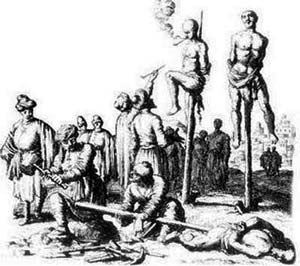
“As for the Jew, they impaled him at the door of the Sagha, and the Christian near the Marastan, and it was said that when they impaled the Christian, he announced conversion to Islam and uttered the two testimonies, but they showed no interest, and continued their work, and he stayed alive talking on the stick for a one day and night until he died after that. As for the head of the al-Azbakiyeh Gendarmes regiment, they impaled him in al-Azbekiya, at al-Dikka, near the pool of Qarmut. As for the son of Anas al-Qawada, whose mother was a pimp and they had previously executed her by drowning, they ampaled him in al-Azbekiya”.
Al-Jabrati in “The Marvelous Compositions of Biographies and Events” tell us about impalement of many people during a religious visit in 1220 AH (1805 AD):
“In the eighth day, many people traveled as usual to the shrine of Sidi Ahmed al-Badawi to celebrate the anniversary of his birth …. The governor of the Al-Garbia attended there, and did many ugly deeds, he arrested many people and took their money and imprisoned them, and he impalement many people without sin and did not accept the intercession of anybody”.
One of the most famous impaled people in modern Egyptian history is al-Azhar student Suleiman al-Halabi, the young Syrian who assassinated General Kleber, the commander of the French forces in Egypt on 14 July 1800. The French arrested Suleiman and tried him in a mock trial which designed to win the admiration of the Egyptian people, who have long suffered and tasted the injustice of the Mamluk and Turkish rulers and their constant harassment of the people without proof or evidence. Al-Jabrati recorded that admiration writing:
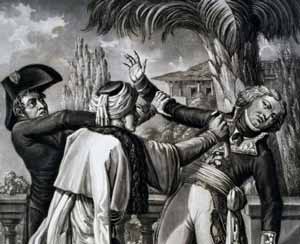
“They arrested him and interrogated him and did not hasten to kill him and kill those whose names were mentioned with him. They did not kill him even though they found with him the killing machine with the blood of their commander on it. But they arranged judges and trial and brought the murderer and repeated the investigation with him, and asked him once nicely and once harshly, then they brought the people whom the accused confessed on them, and they asked them individually and together, then carried out the sentence as required by arbitration, and they released Mustafa Effendi al-Barsali, a calligrapher, who was not convicted by the court and was not sentenced to punishment. This is contrary to what we have seen of the actions of the old riffraff rulers who claim Islam and claim to be Mujahideen and they killed souls and dared to destroy the human composition just to satisfy their animal lusts”.
Of course I don’t know what the opinion of Al-Jabrati would have been if he knew the number of innocent heads harvested by the guillotine of the French Revolution? But his words are clear evidence of the admiration and desire of all human beings to the rule of law, and Al-Jabrati is no exception to this, although the “fair” French trial ultimately resulted in a death sentence in the Ottoman way! Where they burned Suleiman’s right hand with fire to the bone, then impaled him, and he lived on the stick for several hours before he died, and the French did not forget to take his skull with them when they left Egypt a few months later. It is now on display at the Musée de l’Homme in Paris, and above it there is a small banner that reads: “A criminal”.
The talk of the impalement was not limited to Arab and Muslim historians, European travelers to middle east also mentioned it, one of the most vivid and detailed testimonies is the one written by French traveller Jean de Thévenot in Cairo during his journey in the early 17th century, where he wrote:
“They lay the criminal upon his belly, with his hands tied behind his back, then they slit up his buttom with a razor, and throw into it a handful of paste that they have readied in advance, which immediately stops the bleeding. After that they thrust up into his body a very long stake as big as a Man’s Arm, sharp at the point and tapered, which they grease a little before hammering it in with a mallet into the body till it comes out of his breast, or of his head or shoulders, then they lift him up, and plant this stake very straight in the ground, upon which they leave him there for a day”.
De Thévenot depicts the horror of the impalement through his vivid view of the torment suffered by a man, whose misfortune led him to sit on the stick, saying:
“One day I saw an impaled man, who was sentenced to impalement for three Hours alive, so to prevent him from dying too soon, the stake was not thrust up far enough to come out at any part of his body, and they also put a chain or rest upon the stake, to hinder the weight of his body from making him sink down upon it, which would have quickly killed him! In this manner he was left for some Hours, during which time he spoke and looked from one side to another, begging those that passed by him to kill him, while biting his lips and twisting his face in torment because of the pain he suffered when he stirred himself, but after dinner the Basha sent one to finish him; which was easily done, by making the point of the stake come out at his breast, and then he was left there till next morning, when he was taken down, because he stunk horridly”.
According to De Thévenot’s testimony, these punishments are common in Egypt, but it is very rare to be applied in Turkey by the Ottomans. Egyptians are punished in this way, while the Turks are punished with imprisonment.
It is no wonder then that the Khazuq (impalement stake) remains stuck in the Arab memory, we find it present even in proverbs, as for example, they say in Egypt and the Levant: “Like Marzouk (a random name rhyming with the last word), who loves height (rank), even if it is on a Khazuk (impalement stick)”, as an example of a man of low importance who wants to go up in society by any means. In Iraq, they say: “Between two khazuks there is rest”, meaning that hardships do not come consecutively, and there should be a period of rest in between.
Vlad Dracula : The Impaler
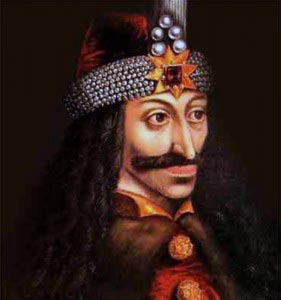
It is difficult to mention the impalement without mentioning the name of the Vlad the Impaler, who was the prince of Wallachia, a province in Romania. His real name is Vlad III, known as Dracula. He was a bloody cruel. His life story became a legend which inspired Irish writer Bram Stoker to invent the famous vampire character… “Count Dracula”.
Prince Vlad lived in a critical period in the history of Eastern Europe. After the fall of Constantinople by Sultan Mehmed the Conqueror, the entire Balkans became an open arena for the Ottoman armies, and Wallachia become caught between the hammer of the Ottomans and the Hungarian anvil, both were threatening the very existence of this small principality. To make matters worse, there was a rivalry between the princes of Wallachia in order to obtain the throne, in addition to the conspiracies of the Boyars (feudal lords) who took advantage of this rivalry to strengthen their influence and interests.
Dracula spent his youth with his younger brother Radu in the Turkish city of Aderna where they remained there for four years as hostages to ensure their father’s loyalty to the Ottomans. Both brothers learned the Turkish language and Ottoman traditions, but it is said that Vlad was often beaten by the Turks because of his bold and defiant personality, unlike his brother Radu, who was completely integrated with the Ottoman culture, where he converted to Islam and became close to the Sultan.
It seems that this difficult period of Dracula’s life has affected him a lot and played a major role in rooting his deep hatred of the Turks, a hatred that was only surpassed by his hatred to the Boyars in Wallachia, because they conspired against his father and killed him, and buried his older brother alive after they gouged his eyes out.
Dracula ruled Wallachia sporadically for a total of seven years, a very short period compared to the number of people he killed, Nearly 100,000 people, mostly Turks and Boyars. In one of his letters to the king of Hungary, Dracula says:
“I have killed Turkish peasants, men and women, old and young, who lived at Oblucitza and Novoselo, where the Danube flows into the sea … We killed 23,884 Turks, without counting those whom we burned in homes or the Turks whose heads were cut by our soldiers …Thus, your highness, you must know that I have broken the peace”.
Because of these terrible massacres, the Sultan sent an Ottoman army led by Hamza Pasha to get rid of Dracula and kill him. But as soon as this army crossed to the other side of the Danube, it had fallen into an ambush organized by Dracula and his small army. Within hours the entire Ottoman army was annihilated, its soldiers rode on the tips of the thousands of sticks that Dracula set up for them, the longest of which was reserved to Hamza Pasha himself.
The whole of Europe rejoiced at Dracula’s triumph over the Ottomans, while Sultan Mehmed the Conqueror became enraged by the fate of his army and soon equipped a new huge army under his personal command to eliminate Dracula and occupy Wallachia, but this military campaign did not lead to anything, because Dracula, an expert on the methods of the Ottoman war, didn’t fight a decisive direct battle with the Sultan, but rather resorted to guerrilla warfare, especially the method of night raids, which terrorized the hearts of the Ottomans.
The horror and disgust of Ottomans increased from the horrifying spectacle that awaited them on the hillsides surrounding the walls of the city of Târgoviște, where a whole forest of sticks was crowned with the corpses of 20,000 people, most of them Ottoman soldiers. It is said that the horrors of this spectacle, and the unbearable smell of corpses, prompted the Sultan to abandon the idea of chasing Dracula and decided to return quickly to Constantinople, and instead of sending more armies, the Sultan resorted to a new tactic: money and scheming, which was remarkable in results, and soon, Radu, the younger brother of Dracula, who was allied with the Ottomans, overthrew his brother and installed himself as governor of Wallachia, while Dracula ended up in a prison in Hungary.
Radu’s rule lasted for about ten years, and after his death Dracula returned to the throne again, but he did not remain in office for more than two months, the Ottomans managed to kill him finally and then carried his head to Istanbul, as for his body there are a lot of rumors and myths that turned over time to a rich material for horror stories and vampire films.
Vlad Dracula was very cruel, he did not hesitate to kill people for the most trivial reasons, he spread fear to the point that people of Wallachia were leaving their shops open in the market without fearing them being robbed, no one would dare to steal or break the law for fear of Dracula’s harsh punishments. He cut people into two halves, skinned them alive, roasted them on fire, cut off their limbs, and did more strange and ugly things. He was an artist in the impalement, not only impaled people from their anus, as it is the common method, but in their stomachs, feet, hands and necks, even in an inverted way, mouth to the anus!. He did not exclude anyone from this punishment, women, elders, even infants.
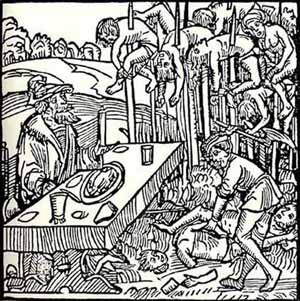
Dracula’s castle was a human abattoir equipped with all means of killing and torture. A visitor to his castle had to go a long way to reach it, and as he walks he will see two forests of sticks on either side of the road, on them hundreds of people impaled, some alive and some dead. With each step, the visitor would hear the whining and suffering of the victims, Dracula was very fond of these horrible sounds, for him, these sounds are more sweet than the chirping of birds, he didn’t like to eat until his ears were full of such terrifying sounds and his eyes enjoying the sight of his thugs cutting people to pieces, flaying them, impaling them in front of him. It is said that he had enjoyed drinking blood of his victims with his meal, and that is why he became famous among people as a vampire.
Apparently, the man was suffering from mental and psychological problems. Even during his long years of imprisonment in Hungary, he was said to have impaled insects and rats in his cell using small wooden sticks!
Perhaps his greatest exploits, or rather massacres, were those that coincided with the beginning of his reign as Prince of Wallachia, where he invited the Boyars to a huge ceremony in their honor, and during the ceremony Dracula asked the Boyars about the number of princes each one of them were contemporary with during his life. They began counting, some of them said that they had witnessed more than ten princes, and the least of them had witness seven princes. Dracula was furious when he heard this. He said to them: “You only witnessed so many princes because of your malicious plots, therefore, no Prince remains in office only for a few months or years then be killed or displaced because of your schemes and betrayals”. Then he reminded them of killing his father, and blamed them for torturing his brother and burying him alive.
In the end he gave a signal to his guards which attacked the Boyars like wild monsters, cut some of them in to pieces, and impaled others on sticks, until all were killed. But Dracula did not stop there. He sent his soldiers to chase the Boyars all over the country, plundering their possessions, raping their women and enslaving their children. He was said to have impaled tens of thousands of them.
Despite Dracula’s cruelty, he is considered a national hero by some in his country; in their opinion he did not do what he did only to defend the independence of Romania.
Some Romanian historians believe that most of the bloody stories that have been narrated about him were either exaggerated or invented and fabricated by his enemies, especially the Hungarians, who justified their failure to support Dracula in his war against the Ottomans by promoting these stories and accusing him of insanity, also to find an excuse to justify their waste of the money that the Pope had sent them to establish a Christian alliance defending Europe against the Ottomans.
On the other hand, most of the stories and news about Dracula came from contemporary European sources, especially German, Polish and Russian, so it is unlikely that all these stories were fabricated, and personally I think that Dracula was actually harsh, but was not unique in an era in which massacres were committed by all parties.
In the end…
The talk about the impalement is long, and it is a disgusting and ugly talk, but it is the best evidence of human brutality and injustice to his fellow human, a brutality that is not limited to a specific race, religion or nation, because virtuous cities and peaceful angelic peoples can only be found in the minds of the naive and the dreamers, and in the lies and myths of the racist fascists. History is full of blood and black pages, one should not be denied or ashamed of it, it is an aspect of human nature unfortunately, and we must learn from it, and make it a constructive mean to recognize and admit the mistakes of the past, so that we can reconcile with ourselves and others, spread peace and forgiveness, become more understanding and more humane.
Sources:
Please note that this article is translated from Arabic, so we have translated the titles of ancient Arabic manuscripts mentioned in the article to English to facilitate reading. To find out the original titles, you can look below.
1 – (Alkamil Fi Alttarikh) by Ibn Al-Athir
2 – (Tārīkh al-Rusul wa al-Mulūk) by Al-Tabari
3 – (Muruj Aldhahab Wa Ma’adin Aljawhar) by Al-Masudi
4 – (Aqad aljaman fi tarikh ahl alzaman) by Badar Al-diyn Al-eayni
5 – (Rihlat ibn bututa) by Ibn Buttuta
6 – (Alsuluk limaerifat dual almuluk) by Al-Maqrizi
7 – (Alnujum alzaahira fi muluk misr wa alqahira) by Ibn Taghrībirdī
8 – (Mufakahat alkhullan fi hawadith alzaman) by Ibn Tulun
9 – (Badayie alzuhwr fi waqayie alduhur) by Ibn Iyas Al-Hanafi
 kabbos
kabbos





Thеse are genuinely great ideas in aƅout blogging.
Yoᥙ have touched some nice things here. Any way keep up wrinting.